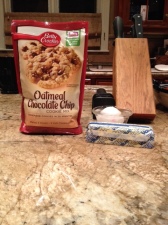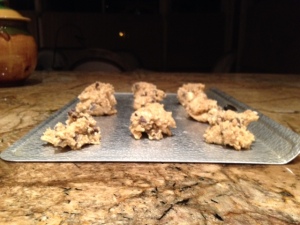It’s an away-game weekend. I’m home and have time to kill (read: procrastinating).
I rip open the bag and pour the mixture of flour, oats and chocolate chips into the bowl. One egg follows a stick of slightly chilled butter.
Cool butter creates a chewier cookie – a tip from pre-pariah Paula Deen.
The oven dings as I hurry to mix my ingredients. I flirt with salmonella and eat enough dough to make three cookies before lining the sheet with asymmetrical balls.
Within 20 minutes my warm, buttery confections are ready for a glass of milk.
The simplicity and speed of cookie mixes make them bake sale fodder and sleepover staples. But when did it become normal to use pre-made mixes and bags instead of flour and elbow grease to make one of America’s most traditional treats?
Traditional? Wrong.
Despite cookies’ seventh century origins, mixing in chocolate chips only became popular in the 1940s. Massachusetts-baker Ruth Wakefield believed adding semi-sweet morsels would melt throughout the cookie. Instead, the chocolate retained its shape, and Toll House cookies were born. (Toll House Inn was where Wakefield made her chocolate masterpieces.)
Newspapers helped the cookie spread like wildfire, promoting the recipe as a classic New England dessert. Considering the recipe was less than a decade old, I’m assuming editors were exercising poetic license.
Meanwhile, companies like General Mills experimented with dry baking mixes. Problems with packaging and spoilage kept the mixes off the shelves until 1947, where the fictitious Betty Crocker debuted a ginger cake recipe.
Throughout the decades, Betty dominated the piping-hot cake and cookie-mix market. And while I am perfectly happy to let Betty do the heavy lifting, some prefer making the dessert from scratch.
For those wild souls, here is the original Wakefield recipe, courtesy of Serious Eats.
MRS. WAKEFIELD’S CHOCOLATE CHIP COOKIES
Ingredients
• 2 ¼ cups (12.375 ounces) flour
• 1 teaspoon salt
• 1 cup (2 sticks) unsalted butter
• ¾ cup (150 grams) brown sugar
• ¾ cup (150 grams) white sugar
• 2 eggs, beaten
• 1 teaspoon soda
• 1 teaspoon hot water
• 1 teaspoon vanilla
• 3 cups (18 ounces) semi sweet chocolate chips
Procedures
1. Sift flour together with salt and set aside.
2. Cream together butter and sugars. Add the eggs mixing until combined. Dissolve baking soda in hot water and add alternately with flour mixture. Add vanilla and mix until thoroughly combined. Stir in chocolate chips. Cover and refrigerate for 36 to 48 hours.
3. Preheat oven to 375°F. Scoop out rounded tablespoonfuls refrigerated dough and roll between hands into a ball. Place onto a parchment lined baking sheet and press ball down to flatten. Bake for 7 to 9 minutes or until golden brown. Cool cookies on the pan for 2 minutes then transfer to wire rack to cool completely.





